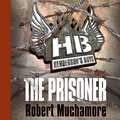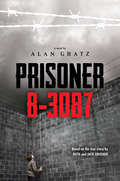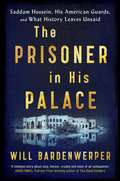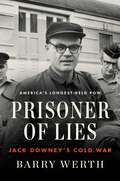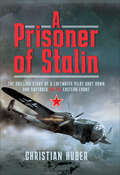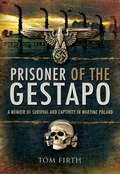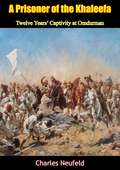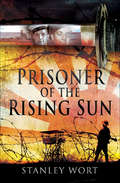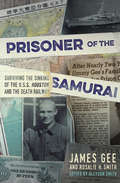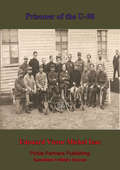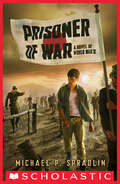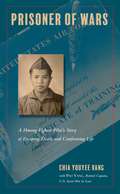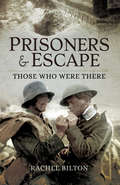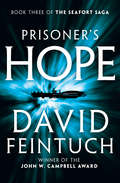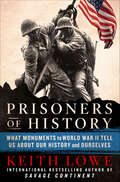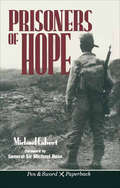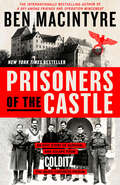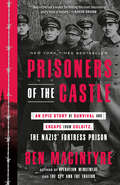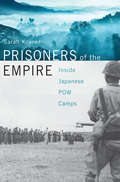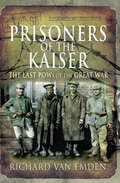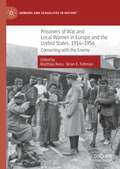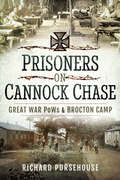- Table View
- List View
The Prisoner: Book 5 (Henderson's Boys #5)
by Robert MuchamoreOne of Henderson's best agents is being held captive in Frankfurt. A set of forged record cards could be his ticket to freedom, but might just as easily become his death warrant. A vital mission awaits him in France - if he can find a way to escape.(P) Hodder Children's Books 2016
Prisoner B-3087
by Ruth Gruener Jack GruenerSurvive. At any cost. 10 concentration camps. 10 different places where you are starved, tortured, and worked mercilessly. It's something no one could imagine surviving. But it is what Yanek Gruener has to face. As a Jewish boy in 1930s Poland, Yanek is at the mercy of the Nazis who have taken over. Everything he has, and everyone he loves, have been snatched brutally from him. And then Yanek himself is taken prisoner -- his arm tattooed with the words PRISONER B-3087. He is forced from one nightmarish concentration camp to another, as World War II rages all around him. He encounters evil he could have never imagined, but also sees surprising glimpses of hope amid the horror. He just barely escapes death, only to confront it again seconds later. Can Yanek make it through the terror without losing his hope, his will -- and, most of all, his sense of who he really is inside? Based on an astonishing true story.
The Prisoner in His Palace: Saddam Hussein, His American Guards, and What History Leaves Unsaid
by Will BardenwerperThe Prisoner in His Palace is an evocative and thought-provoking account of how the lives of twelve young American soldiers deployed to Iraq are upended when they’re asked to guard the most ‘high-value detainee’ of all, the notorious dictator Saddam Hussein. What the self-dubbed ‘Super Twelve’ experience in the autumn of 2006 is cognitive dissonance at its most extreme. Expecting to engage with the enemy ‘outside the wire’, they’re suddenly tasked with guarding and protecting a notorious dictator until he can be hanged. Watching over Saddam in a former palace the soldiers dub ‘The Rock’ and regularly transporting their prisoner to his raucous trial, they gradually begin to question some of their firmest beliefs. Rather than the snarling beast they expect, Saddam proves confoundingly complex – voluble, charming and given to surprising displays of affection. Perhaps most shockingly, in his Spartan stoicism and the courage he shows in facing death he eventually becomes a role model. Employing a timeline that switches between present and past, The Prisoner in His Palace contrasts the man entrusted to the Super Twelve’s care – a grandfatherly figure who proves ‘good company’ – with a younger version of Saddam who is unspeakably ruthless, views murder and torture as legitimate tools and constantly keeps those around him in a blind panic. The magic of this book is that Bardenwerper keeps us on edge even though we know how it will end. We immediately sense that the Super Twelve will be forever changed by their experience, and we wonder if we ourselves will. In this artfully constructed narrative, Saddam, the ‘man without a conscience’, manages to get everyone around him to examine theirs.
Prisoner of Lies: Jack Downey's Cold War
by Barry WerthThe remarkable true story of the longest-held prisoner of war in American history, John Downey, Jr., a CIA officer captured in China during the Korean War and imprisoned for twenty-one years.John (Jack) Downey, Jr., was a new Yale graduate in the post-World War II years who, like other Yale grads, was recruited by the young CIA. He joined the Agency and was sent to Japan in 1952, during the Korean War. In a violation of protocol, he took part in an air drop that failed and was captured over China. His sources on the ground had been compromised, and his identity was known. Although he first tried to deny who he was, he eventually admitted the truth. But government policy forbade ever acknowledging the identity of spies, no matter the consequences. Washington invented a fictitious cover story and stood by it through four Administrations. As a result, Downey was imprisoned during the decades that Red China, as it was called, was considered by the US to be a hostile nation, until 1973, when the US finally recognized the mainland Chinese government. He had spent twenty-one years in captivity. Downey would go on to become a lawyer and an esteemed judge in Connecticut, his home state. Prisoners of Lies is based in part on a prison memoir that Downey wrote several years after his release. Barry Werth fluently weaves excerpts from the memoir with the Cold War events that determined Downey&’s fate. Like a le Carré novel, this is a harrowing, chilling story of one man whose life is at the mercy of larger forces outside of his control; in Downey&’s case as a pawn of the Cold War, and more specifically the Oval Office and the State Department. His freedom came only when US foreign policy dramatically changed. Above all, Prisoner of Lies is an inspiring story of remarkable fortitude and resilience.
A Prisoner of Stalin: The Chilling Story of a Luftwaffe Pilot Shot Down and Captured on the Eastern Front
by Christian Huber Gerhard EhlertLeutnant Gerhard Ehlert was one of the few survivors of 2. Nachtaufklärungsstaffel, part of the Luftwaffe’s 6th Air Fleet, which operated on Eastern Front during the Second World War. Although he came from a family that spoke out against Hitler and the Nazi regime, he volunteered to join the Luftwaffe. He went on to undertake combat patrols under the most extreme circumstances. Facing hazardous weather conditions – often landing his aircraft ‘blind’ in heavy fog – and mountainous odds against Soviet air superiority, Ehlert completed twenty-two sorties before his Dornier Do 217M-1, coded K7+FK, was shot down on 14 June 1944. Despite strenuous efforts to escape the Soviets, along with his rear-gunner Feldwebel Wilhelm Burr, he was captured by the Red Army. What followed changed his life forever. Though interrogated repeatedly, Ehlert revealed nothing about his missions or duties. Then, during his transfer to a prisoner of war camp, he had to face a hostile crowd of Russian civilians who had suffered from the devastating effects of the Luftwaffe’s bombs. In the long journey eastwards across the bleak Russian steppes to the camp at Yelabuga, a town in the Republic of Tatarstan, Ehlert reflected on his early years and the road he took to the east and the horrifying situation he was in. But it was not the months he endured in the freezing prisoner of war camp which became his most haunting memory – it was when the war ended. The Russians announced that with peace came new rules. Now the prisoners must work and the food ration would be reduced. Their uniforms were removed, and all privileges of rank dismissed. To the Soviets they were no longer prisoners of war, they were mere criminals and were treated accordingly. Transferred to Bolshoy Bor in the north, day after day the men had to transport logs, even through the snow and ice of winter, with many of the prisoners dying of malnutrition and exposure. The Russians told them they were ‘to rebuild what they destroyed in the Soviet Union’. Ehlert’s suffering finally ended in 1949. He was able to return to his parental home, initially being treated as an unwelcome stranger. When he related his story to Christian Huber, Gerhard Ehlert was in his 90s, by then a happy father and grandfather, and undoubtedly a survivor.
Prisoner of the Gestapo: A Memoir of Survival and Captivity in Wartime Poland
by Tom FirthTom Firth was born in Japan where his English father and Polish mother were living. He begins by describing his unusual childhood and the devastating Yokohama earthquake in 1923. In 1930 the family settled in Warsaw, Poland. However they became split up when Poland became overrun by the Nazis and the Russians in 1939. Whilst his father and older brother were in England, Tom found himself trapped in the Russian-occupied part of the country and, after several agonizing months, eventually made his way to Warsaw where his mother had managed to survive the bombing of the city. He vividly describes life under both regimes, as well as the cat-and-mouse game his mother was forced to play with the Gestapo in order to avoid arrest. Later, both became deeply involved with the sheltering of escaped British prisoners of war and it was this activity which led to his capture and imprisonment in a jail in Krakow. Miraculously released after eighteen months captivity, largely due to his command of the Polish language, he vowed to escape to Britain at all cost.Later in the war and after many harrowing experiences he succeeded in getting through to the Red Army, but was again faced with hostility, suspicion and imprisonment. Held for several months in primitive conditions, he, along with two British companions was finally taken to Moscow and handed over to the British Military Mission there. Arriving in Scotland with a convoy of supply ships late in December 1944, he had the galling experience of spending a night in Brixton Prison. With nowhere to go he then began a frantic search for his father and brother, who were convinced that he was dead. His dream came true, but even after the ending of hostilities and later in time, tragedy struck with the news of his mothers arrest by the Polish Communist authorities. Sentenced to death for alleged espionage, she spent several years in prison, being freed in a Government amnesty and arriving in England in 1956.
A Prisoner of the Khaleefa: Twelve Years’ Captivity at Omdurman [Illustrated Edition] (Trubner's African Ser.)
by Charles NeufeldIn 1887, German merchant Karl (Charles) Neufeld was captured by the Mahdists and transferred to Omdurman, where he spent twelve years in prison.This is his gripping account, translated from German into English and first published in 1899, the year of his release by the British Commander-in-Chief Hebert Kitchener. Neufeld retells in vivid detail his capture, torture and imprisonment by the Dervishes, the death of Gordon at Khartoum, and the conquest of the Sudan by the British Army.An unmissable read.Richly illustrated with a special picture and map pack.
Prisoner of the Rising Sun
by Stanley WortThis is the story of a young man thrust into the Royal Navy in distant Hong Kong. He relates some of the humorous situations in which he found himself and provides a realistic account of what life was like for servicemen in pre war Hong Kong.It describes the prelude to war from his point of view and his part in the Battle for Hong Kong. There follows the story of what happened to him when taken prisoner and life and death in prison camps in Hong Kong and Japan. It tells what it was like to be shipped to Japan in the hold of Japanese merchant men with constant fear of being torpedoed.In Japan itself he and his fellow prisoners were used as slave labor. Treatment was harsh and brutal and although many of them died the Japanese never broke the spirit of the survivors.The author explains how it felt to be a prisoner working in a Japanese factory when a major earthquake struck. He also relates what it was like to be on the receiving end of a B29 fire raid and what the Japanese did to downed American airmen. In August 1945 he saw the Japanese bow before loudspeakers and although he did not realize it then, heard the Japanese Emperor announce the surrender of Japan. The book contains a tribute to the efficiency and kindness of the American forces that got him out and on his way home.
Prisoner of the Samurai: Surviving the Sinking of the USS Houston and the Death Railway
by James Gee Rosalie H. SmithCourage on the River Kwai—the inspiring true story of one marine&’s resilience in a World War II POW camp following the Battle of the Sunda Strait. Two months after the bombing of Pearl Harbor, between the islands of Java and Sumatra, the naval cruiser USS Houston sank after taking four torpedo hits by Imperial Japanese warships. Among the survivors clinging to makeshift rafts was James Gee, PFC, USMC. Rescued by the enemy, Gee was transferred to Rangoon and subjected to hard labor in the construction of the Burma Railway. Here on the muddy banks of the River Kwai, thousands of allied prisoners succumbed to the harsh conditions. Again, Gee survived. But the worst was yet to come. A fresh hell awaited 2,700 miles away: a Japanese POW camp where the young marine would remain until the end of the war. This is the remarkable memoir of one man&’s three-year ordeal amid the direst conditions imaginable—and how the compassion and companionship of his fellow allies strengthened his resolve, and turned desperation into an unbeatable will to make it back home alive.
Prisoner Of The U-90
by Edouard Victor Michel IzacOf the many weapons in the German arsenal during the First World War amongst the most effective were the silent undersea craft of the Kreigsmarine. The U-Boats prowled the oceans looking for prey, after the Kaiser removed all restrictions on the U-Boat captains in 1916 they could sink indiscriminately. As the troops of the United States pored over the Atlantic after the declaration of War in 1917 the U-Boats beneath the waves would have fresh targets. As the U.S.S. President Lincoln, a converted troop transport, returned to the United States, having set her cargo of soldiers on to French soil, she was suddenly torpedoed by the U-90. As the ship slowly sank a handful of her naval personnel were picked up by the submarine. Among them was Lieutenant Izac, who would earn the Congressional Medal of Honor for his successful escape from the clutches of his German captors.Author --Edouard Victor Michel Izac.Text taken, whole and complete, from the edition published in Boston, Houghton, Mifflin company, 1919.Original Page Count - vii and 184 pages.Illustrations -- 2 plans
Prisoner of War: Six Years in Hanoi
by John M. McGrathJohn M. McGrath, a young Navy pilot who was captured in 1967 after being shot down over Vietnam, vividly presents a straightforward and compelling tale of survival, of years of suffering, and of the human will to endure. <p><p>During the era of the unpopular Vietnam War few issues united the American people as did the emotion-laden problem of POWs and MIAs. When the peace treaties were finally signed and the POWs returned to American soil, the nation was collectively relieved by their safe return. <p><p>A self-taught artist, the starkness of McGrath's drawings underscores his remarkable and moving chronicle of the lives of these prisoners, who were constantly in peril, attempting to survive a brutal captivity almost unimaginable in civilized times.
Prisoner of War
by Michael P. SpradlinSurvive the war. Outlast the enemy. Stay alive. That's what Henry Forrest has to do. When he lies about his age to join the Marines, Henry never imagines he'll face anything worse than his own father's cruelty. But his unit is shipped off to the Philippines, where the heat is unbearable, the conditions are brutal, and Henry's dreams of careless adventuring are completely dashed. Then the Japanese invade the islands, and US forces there surrender. As a prisoner of war, Henry faces one horror after another. Yet among his fellow captives, he finds kindness, respect, even brotherhood. A glimmer of light in the darkness. And he'll need to hold tight to the hope they offer if he wants to win the fight for his country, his freedom . . . and his life. Michael P. Spradlin's latest novel tenderly explores the harsh realities of the Bataan Death March and captivity on the Pacific front during World War II.
Prisoner of Wars: A Hmong Fighter Pilot's Story of Escaping Death and Confronting Life (Asian American History & Cultu #222)
by Chia Youyee VangRetired Captain Pao Yang was a Hmong airman trained by the U.S. Air Force and CIA to fly T-28D aircraft for the U.S. Secret War in Laos. However, his plane was shot down during a mission in June 1972. Yang survived, but enemy forces captured him and sent him to a POW camp in northeastern Laos. He remained imprisoned for four years after the United States withdrew from Vietnam because he fought on the American side of the war. Prisoner of Wars shows the impact the U.S Secret War in Laos had on Hmong combatants and their families. Chia Vang uses oral histories thatpoignantly recount Yang’s story and the deeply personal struggles his loved ones—who feared he had died—experienced in both Southeast Asia and the United States. As Yang eventually rebuilt his life in America, he grappled with issues of freedom and trauma. Yang’s life provides a unique lens through which to better understand the lasting impact of the wars in Southeast Asia and the diverse journeys that migrants from Asia made over the last two centuries. Prisoner of Wars makes visible an aspect of the collateral damage that has been left out of dominant Vietnam War narratives.
Prisoner of Wars: A Hmong Fighter Pilot's Story of Escaping Death and Confronting Life (Asian American History & Cultu #222)
by Chia Youyee VangRetired Captain Pao Yang was a Hmong airman trained by the U.S. Air Force and CIA to fly T-28D aircraft for the U.S. Secret War in Laos. However, his plane was shot down during a mission in June 1972. Yang survived, but enemy forces captured him and sent him to a POW camp in northeastern Laos. He remained imprisoned for four years after the United States withdrew from Vietnam because he fought on the American side of the war. Prisoner of Wars shows the impact the U.S Secret War in Laos had on Hmong combatants and their families. Chia Vang uses oral histories thatpoignantly recount Yang’s story and the deeply personal struggles his loved ones—who feared he had died—experienced in both Southeast Asia and the United States. As Yang eventually rebuilt his life in America, he grappled with issues of freedom and trauma. Yang’s life provides a unique lens through which to better understand the lasting impact of the wars in Southeast Asia and the diverse journeys that migrants from Asia made over the last two centuries. Prisoner of Wars makes visible an aspect of the collateral damage that has been left out of dominant Vietnam War narratives.
Prisoners & Escape: Those Who Were There
by Rachel BiltonA wide range of personal experiences are covered in the eleven chapters of this book. Nearly all the stories are written by the participants who describe exactly what happened to them during the war. What makes them special is that they were written while the images were fresh in their minds. The experiences recorded are those of civilians and soldiers. Where possible information about these men has been provided to explain their life before and after the war. Also included are rarely seen images that augment the text.The writers tell true stories of spying, escape from certain death, escape from captivity and working for the Germans to help the Allied war effort. Edwin Woodhall describes his work in counter-intelligence, spies, counter-spies and disguises, in the early days of the war. Harold Beaumont tells the dramatic story of his escape through Belgium where he was helped by Nurse Cavell. The hardships and difficulties an escaper faced are detailed by Walter Ellison, who failed to get away, while a successful escape is told by Duncan Grinnell-Milne who returned to flying over the Western Front and quickly found himself in no mans land when his plane crashed. Captain Evans was eventually a successful escaper as was H.G. Durnford who managed to escape the first time. Marthe McKenna, one of the most famous spies in the war, tells of the time she was ordered to investigate and assist in a plot to assassinate the Kaiser. Esmee Sartorius tells of her escape to Holland at the start of the war, and the breath-taking thrills of two men disguised as German officers is told by Lieutenant Marchal. The final story describes how Trooper Potts escaped certain death while rescuing his friend on Burnt Hill in Gallipoli.
Prisoner's Hope (The Seafort Saga #3)
by David FeintuchThe third book in the military science fiction series is &“a splendid homage to the grand tradition of the old seafarer&’s tale&” (Roger MacBride Allen, author of the Star Wars Corellian Trilogy). While recovering from the physical and emotional wounds he sustained in Challenger&’s Hope, Nick Seafort is named as the liaison between the wealthy planters of Hope Nation and the United Nations Navy. The lurking, acid-spewing, fish-shape aliens are a real threat, and everyone is on edge. When the fleet returns to Earth, dissent grows among the people of Hope Nation, who feel abandoned by the military and left at the mercy of the alien horde. The Seafort Saga continues as Nick Seafort takes on powerful rebels at home, the cold-blooded aliens, and his own self-doubt. He must make a choice that could save Hope Nation, but would also sentence him to death.
Prisoners of History: What Monuments to World War II Tell Us About Our History and Ourselves
by Keith LoweA look at how our monuments to World War II shape the way we think about the war by an award-winning historian.Keith Lowe, an award-winning author of books on WWII, saw monuments around the world taken down in political protest and began to wonder what monuments built to commemorate WWII say about us today. Focusing on these monuments, Prisoners of History looks at World War II and the way it still tangibly exists within our midst. He looks at all aspects of the war from the victors to the fallen, from the heroes to the villains, from the apocalypse to the rebuilding after devastation. He focuses on twenty-five monuments including The Motherland Calls in Russia, the US Marine Corps Memorial in the USA, Italy’s Shrine to the Fallen, China’s Nanjin Massacre Memorial, The A Bomb Dome in Hiroshima, the balcony at Yad Vashem in Jerusalem and The Liberation Route that runs from London to Berlin. Unsurprisingly, he finds that different countries view the war differently. In monuments erected in the US, Lowe sees triumph and patriotic dedications to the heroes. In Europe, the monuments are melancholy, ambiguous and more often than not dedicated to the victims. In these differing international views of the war, Lowe sees the stone and metal expressions of sentiments that imprison us today with their unchangeable opinions. Published on the 75th anniversary of the end of the war, Prisoners of History is a 21st century view of a 20th century war that still haunts us today.
Prisoners of Hope
by Michael CalvertOf the many thousands of books that have been written about the Second World War, Prisoners of Hope is one of the very few acknowledged masterpieces. A devoted disciple of Wingate, of Chindit fame, Calvert accompanied him on the first controversial journey behind the Japanese lines, and after Wingate's tragic death, became the lading protagonist on behalf of Wingate's ideas and the staunchest defender of his reputation. Prisoners of Hope is the classic work on Guerilla warfare as experienced by the commander in action.
Prisoners of the Castle: An Epic Story of Survival and Escape from Colditz, the Nazis' Fortress Prison
by Ben MacintyreFrom the bestselling author of The Spy and the Traitor, a definitive and surprising new narrative of one of history's most famous prisons--and the remarkable cast of POWs who tried to relentlessly escape their Nazi captors.The myth of Colditz, the most infamous prison in history, has stood unchallenged for 70 years: prisoners of war, mustaches firmly set on stiff upper lips, defying the Nazis by tunnelling out of a grim Gothic castle on a German hilltop. Like all legends, that story contains only part of the truth. In Ben Macintyre's brilliant, cliche-smashing new history, he offers a vision of Colditz previously unimagined, a story of much more than an escape, just as the prison's inmates were far more complicated than the cardboard saints depicted in post-war pop culture. Colditz was a miniature replica of office-class society at the time, only far stranger: a lethal, high stakes boarding school surrounded by barbed wire, initially containing prisoners of all Allied nations, including Canada, but eventually only Britons and Americans, a heavily guarded cage with its own culture, eccentricities, and internal tensions. In intimate and compelling detail, Macintyre explores what happens to people when they are locked up without committing a crime and with no idea when or if they might be liberated. Colditz, then, is a tale of the indomitable human spirit, but also one of snobbery, class conflict, hidden sexuality, bullying, espionage, boredom, insanity, and farce. With access to declassified archives, private papers, and never-before-seen photos, the author reveals a remarkable cast of characters, previously hidden from history: Indian doctor Birendranath Mazymdar, the only non-white prisoner, whose ill-treatment, hunger-strike and eventual escape reads like fiction; Florimond Duke, America's oldest paratrooper and least successful secret agent; Christoper Clayton Hutton, the brilliant inventor employed by British intelligence to manufacture escape aids for POWs, from maps hidden in playing cards to a compass secreted inside a walnut; and many others. Bringing together the wartime intrigue of his acclaimed Operation Mincemeat and keen psychological portraits of his bestselling true-life spy stories, Macintyre has breathed stunning new life into one of the greatest war stories ever told.
Prisoners of the Castle: An Epic Story of Survival and Escape from Colditz, the Nazis' Fortress Prison
by Ben MacintyreNEW YORK TIMES BESTSELLER • The &“entertaining [and] often-moving account&” (The Wall Street Journal) of the remarkable POWs whose relentlessly creative attempts to escape a notorious Nazi prison embodied the spirit of resistance against fascism, from the author of The Spy and the Traitor&“Macintyre has a knack for finding the most fascinating story lines in history.&”—David Grann, author of The Wager and Killers of the Flower MoonIn this gripping narrative, Ben Macintyre tackles one of the most famous prison stories in history and makes it utterly his own. During World War II, the German army used the towering Colditz Castle to hold the most defiant Allied prisoners. For four years, these prisoners of the castle tested its walls and its guards with ingenious escape attempts that would become legend.But as Macintyre shows, the story of Colditz was about much more than escape. Its population represented a society in miniature, full of heroes and traitors, class conflicts and secret alliances, and the full range of human joy and despair. In Macintyre&’s telling, Colditz&’s most famous names—like the indomitable Pat Reid—share glory with lesser known but equally remarkable characters like Indian doctor Birendranath Mazumdar whose ill treatment, hunger strike, and eventual escape read like fiction; Florimond Duke, America&’s oldest paratrooper and least successful secret agent; and Christopher Clayton Hutton, the brilliant inventor employed by British intelligence to manufacture covert escape aids for POWs.Prisoners of the Castle traces the war&’s arc from within Colditz&’s stone walls, where the stakes rose as Hitler&’s war machine faltered and the men feared that liberation would not come soon enough to spare them a grisly fate at the hands of the Nazis. Bringing together the wartime intrigue of his acclaimed Operation Mincemeat and keen psychological portraits of his bestselling true-life spy stories, Macintyre has breathed new life into one of the greatest war stories ever told.
Prisoners of the Empire: Inside Japanese Pow Camps
by Sarah KovnerA pathbreaking account of World War II POW camps, challenging the longstanding belief that the Japanese Empire systematically mistreated Allied prisoners.In only five months, from the attack on Pearl Harbor in December 1941 to the fall of Corregidor in May 1942, the Japanese Empire took prisoner more than 140,000 Allied servicemen and 130,000 civilians from a dozen different countries. From Manchuria to Java, Burma to New Guinea, the Japanese army hastily set up over seven hundred camps to imprison these unfortunates. In the chaos, 40 percent of American POWs did not survive. More Australians died in captivity than were killed in combat.Sarah Kovner offers the first portrait of detention in the Pacific theater that explains why so many suffered. She follows Allied servicemen in Singapore and the Philippines transported to Japan on “hellships” and singled out for hard labor, but also describes the experience of guards and camp commanders, who were completely unprepared for the task. Much of the worst treatment resulted from a lack of planning, poor training, and bureaucratic incoherence rather than an established policy of debasing and tormenting prisoners. The struggle of POWs tended to be greatest where Tokyo exercised the least control, and many were killed by Allied bombs and torpedoes rather than deliberate mistreatment.By going beyond the horrific accounts of captivity to actually explain why inmates were neglected and abused, Prisoners of the Empire contributes to ongoing debates over POW treatment across myriad war zones, even to the present day.
Prisoners of the Kaiser: The Last POWs of the Great War (Voices Of The Veterans Ser.)
by Richard van EmdenBased on interviews with survivors of German WWI prison camps, this account documents the heroism and perseverance of British troops in captivity.Drawing on the memories of the last surviving prisoners of the Great war, Prisoners of the Kaiser tells the dramatic story of life as a POW in Germany. Stories include the shock of capture on the Western Front, to the grind of daily life in imprisonment in German prison camps. Veterans recall work in salt mines, punishments, and escape attempts, as well as the torture of starvation and the relief at their eventual release. With over 200 photographs and illustrations, Prisoners of the Kaiser is filled with vivid, moving eye-witness accounts, almost all of which never been have published before.
Prisoners of War
by Steve YarbroughIt is 1943, and the war has come home to Loring, Mississippi. As German POWs labor in the cotton fields, the local draft board sends boys into uniform, and families receive flags and condolences. But for Dan Timms, just shy of 18, the war is his ticket out of town and away from the ghosts that haunt him. As he peddles goods from a rolling store for his profiteer uncle, Dan tries to understand his friend L. C. , a young man who, on account of his skin, feels like a prisoner himself. But one day, Dan spots Marty Stark who has just returned from Italy, mysteriously reassigned to guard the POWs he was once trained to kill. As Dan soon learns, Marty's war is far from over and threatens to erupt again.
Prisoners of War and Local Women in Europe and the United States, 1914-1956: Consorting with the Enemy (Genders and Sexualities in History)
by Matthias Reiss Brian K. FeltmanThis book brings together historians from Great Britain, the United States, Germany, France, Canada, Austria, and Latvia who have worked and published on fraternisation between Prisoners of War and local women during either the First or Second World War, providing the first comparative study of this multi-faceted phenomenon in different belligerent countries. By focusing on prisoners as wartime migrants and studying the nature and impact of their interactions with the local female population, this book expands the existing framework on prisoner of war studies. Its substantial scope and comparative approach make it an important point of reference in the growing research field of POW studies.
Prisoners on Cannock Chase: Great War PoWs & Brockton Camp
by Richard PursehouseThe “fascinating” story of a First World War prisoner of war camp which held captured German personnel in the very heart of the English countryside (Books Monthly).Richard Pursehouse first became aware of the existence of a camp while walking over Cannock Chase in Staffordshire, finding sewer covers in what appeared to be uninhabited heathland. Intrigued, the author set out to investigate the mystery and discovered that the sewers were for two Army camps—Brocton and Rugeley—that had been constructed for soldiers training during the First World War. What he also found, however, was that the Brocton Camp site also included a segregated autonomous prisoner of war camp. With the aid of an old postcard, Richard was able to identify the exact location and layout of the long-lost camp. His research continued until he had accumulated an enormous amount of detail about the camp and life for its prisoners. He found a file by the Camp Commandant, Swiss Legation correspondence, stories in newspapers, letters and diaries, and received photographs from interested individuals. Amongst his finds was a box holding scores of fascinating letters sent home by an administration clerk while he was working at the camp. During his investigations, Richard also learned of attempted murders and escapes (including the only escapee to make it back to Germany), deaths, thefts—and a fatal scandal. The letters, documents and diaries reveal how the prisoners coped with incarceration, as well as their treatment, both in terms of camp conditions and their medical needs. The result is a unique insight into what life was like inside a British Prisoner of War camp during the First World War.
